Osteoarthritis Treatment and Management
VerifiedAdded on 2020/03/16
|13
|3463
|151
AI Summary
This assignment delves into the various treatments available for osteoarthritis, focusing on pain management strategies like paracetamol, buprenorphine patches, and moxibustion. It also examines the potential risks associated with intra-articular corticosteroid injections and antidepressant medications in treating osteoarthritis-related pain. The analysis considers guidelines from organizations like the American Academy of Orthopaedic Surgeons (AAOS) and NICE, alongside recent studies on treatment efficacy and safety.
Contribute Materials
Your contribution can guide someone’s learning journey. Share your
documents today.
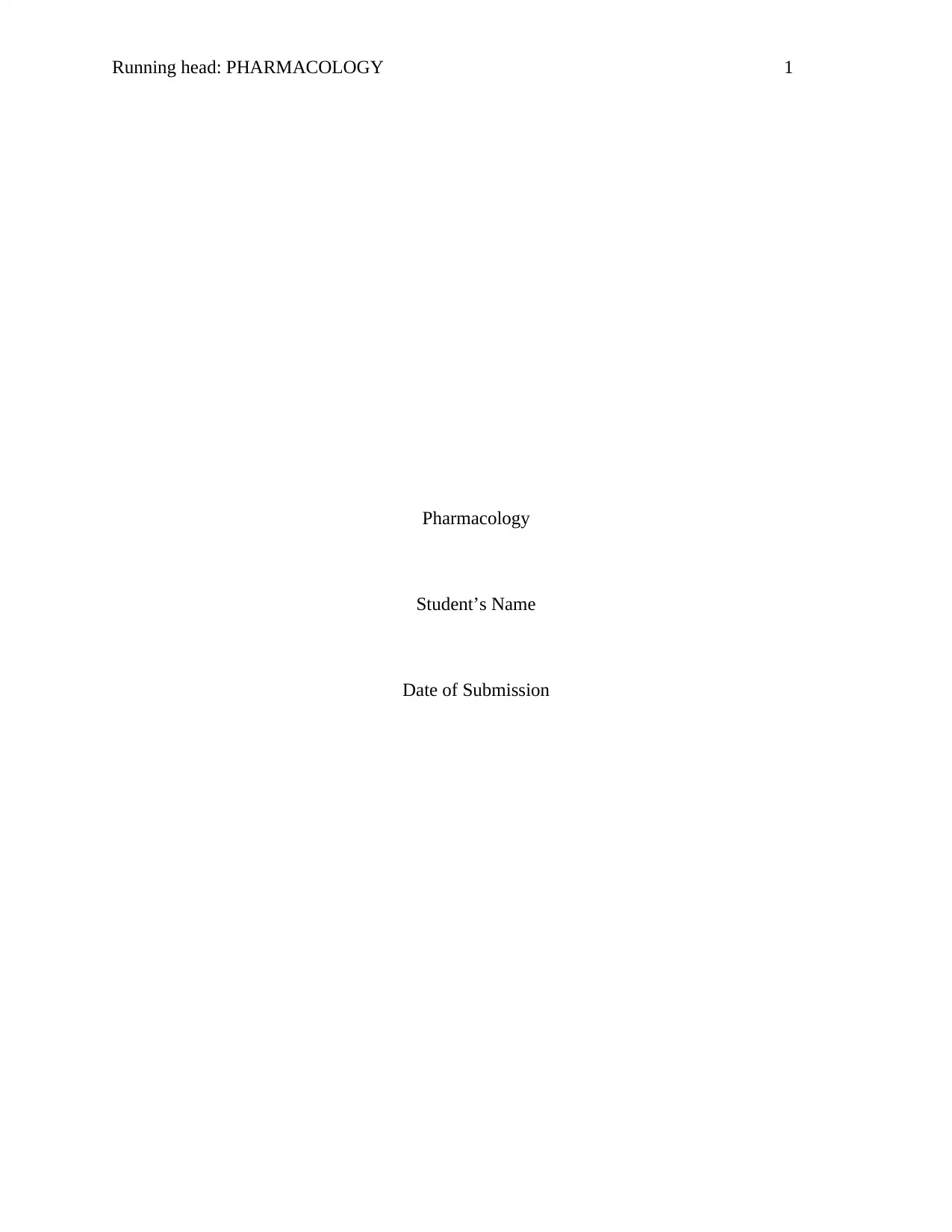
Running head: PHARMACOLOGY 1
Pharmacology
Student’s Name
Date of Submission
Pharmacology
Student’s Name
Date of Submission
Secure Best Marks with AI Grader
Need help grading? Try our AI Grader for instant feedback on your assignments.
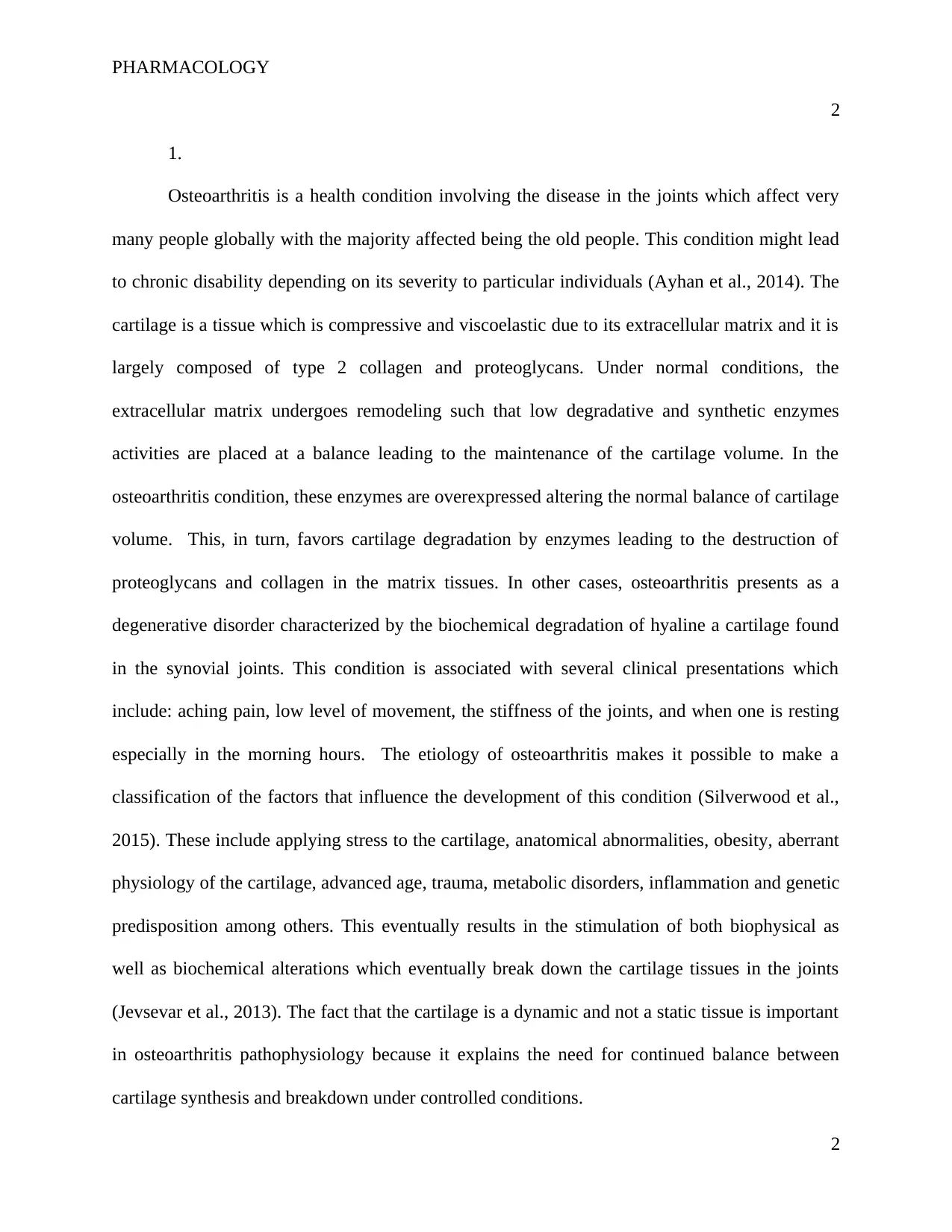
PHARMACOLOGY
2
1.
Osteoarthritis is a health condition involving the disease in the joints which affect very
many people globally with the majority affected being the old people. This condition might lead
to chronic disability depending on its severity to particular individuals (Ayhan et al., 2014). The
cartilage is a tissue which is compressive and viscoelastic due to its extracellular matrix and it is
largely composed of type 2 collagen and proteoglycans. Under normal conditions, the
extracellular matrix undergoes remodeling such that low degradative and synthetic enzymes
activities are placed at a balance leading to the maintenance of the cartilage volume. In the
osteoarthritis condition, these enzymes are overexpressed altering the normal balance of cartilage
volume. This, in turn, favors cartilage degradation by enzymes leading to the destruction of
proteoglycans and collagen in the matrix tissues. In other cases, osteoarthritis presents as a
degenerative disorder characterized by the biochemical degradation of hyaline a cartilage found
in the synovial joints. This condition is associated with several clinical presentations which
include: aching pain, low level of movement, the stiffness of the joints, and when one is resting
especially in the morning hours. The etiology of osteoarthritis makes it possible to make a
classification of the factors that influence the development of this condition (Silverwood et al.,
2015). These include applying stress to the cartilage, anatomical abnormalities, obesity, aberrant
physiology of the cartilage, advanced age, trauma, metabolic disorders, inflammation and genetic
predisposition among others. This eventually results in the stimulation of both biophysical as
well as biochemical alterations which eventually break down the cartilage tissues in the joints
(Jevsevar et al., 2013). The fact that the cartilage is a dynamic and not a static tissue is important
in osteoarthritis pathophysiology because it explains the need for continued balance between
cartilage synthesis and breakdown under controlled conditions.
2
2
1.
Osteoarthritis is a health condition involving the disease in the joints which affect very
many people globally with the majority affected being the old people. This condition might lead
to chronic disability depending on its severity to particular individuals (Ayhan et al., 2014). The
cartilage is a tissue which is compressive and viscoelastic due to its extracellular matrix and it is
largely composed of type 2 collagen and proteoglycans. Under normal conditions, the
extracellular matrix undergoes remodeling such that low degradative and synthetic enzymes
activities are placed at a balance leading to the maintenance of the cartilage volume. In the
osteoarthritis condition, these enzymes are overexpressed altering the normal balance of cartilage
volume. This, in turn, favors cartilage degradation by enzymes leading to the destruction of
proteoglycans and collagen in the matrix tissues. In other cases, osteoarthritis presents as a
degenerative disorder characterized by the biochemical degradation of hyaline a cartilage found
in the synovial joints. This condition is associated with several clinical presentations which
include: aching pain, low level of movement, the stiffness of the joints, and when one is resting
especially in the morning hours. The etiology of osteoarthritis makes it possible to make a
classification of the factors that influence the development of this condition (Silverwood et al.,
2015). These include applying stress to the cartilage, anatomical abnormalities, obesity, aberrant
physiology of the cartilage, advanced age, trauma, metabolic disorders, inflammation and genetic
predisposition among others. This eventually results in the stimulation of both biophysical as
well as biochemical alterations which eventually break down the cartilage tissues in the joints
(Jevsevar et al., 2013). The fact that the cartilage is a dynamic and not a static tissue is important
in osteoarthritis pathophysiology because it explains the need for continued balance between
cartilage synthesis and breakdown under controlled conditions.
2
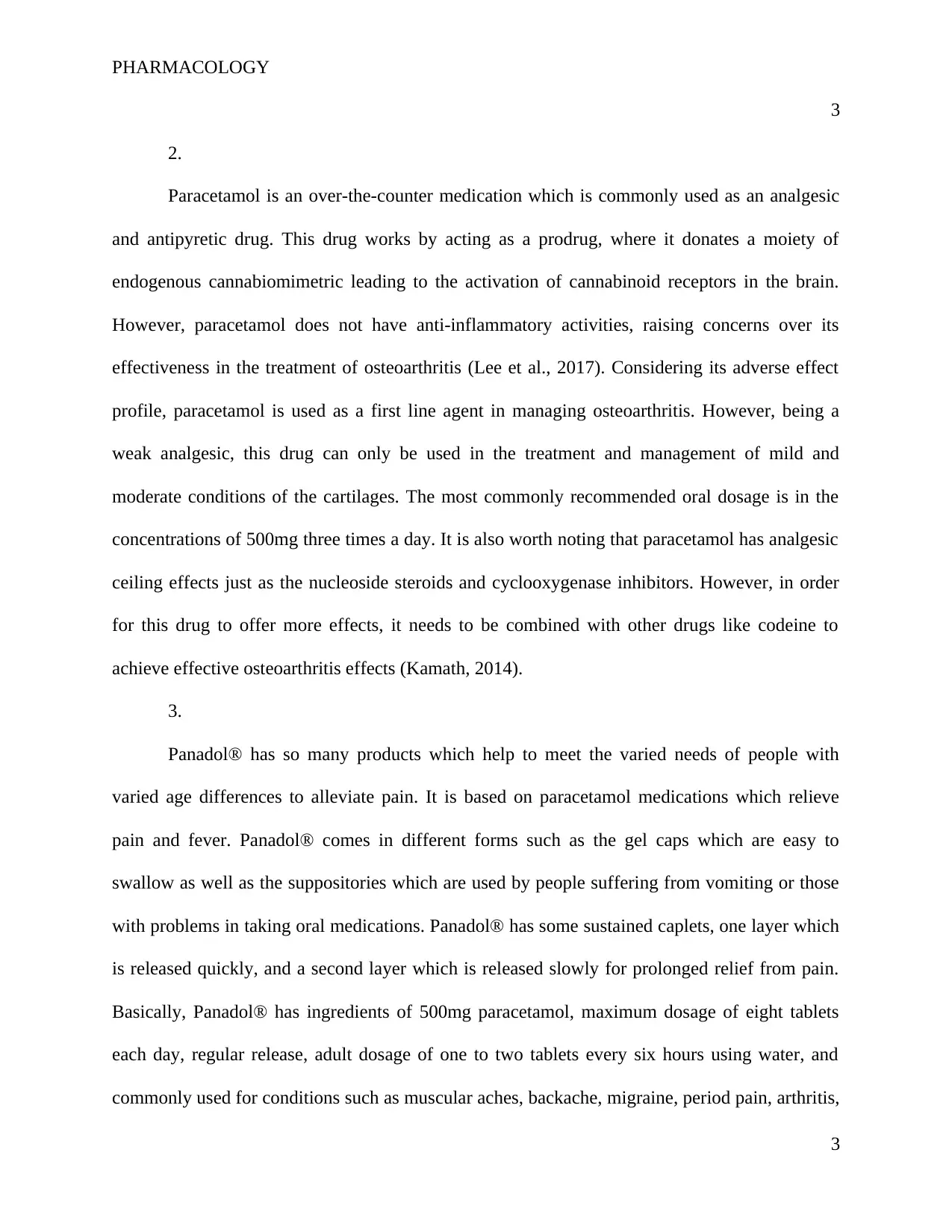
PHARMACOLOGY
3
2.
Paracetamol is an over-the-counter medication which is commonly used as an analgesic
and antipyretic drug. This drug works by acting as a prodrug, where it donates a moiety of
endogenous cannabiomimetric leading to the activation of cannabinoid receptors in the brain.
However, paracetamol does not have anti-inflammatory activities, raising concerns over its
effectiveness in the treatment of osteoarthritis (Lee et al., 2017). Considering its adverse effect
profile, paracetamol is used as a first line agent in managing osteoarthritis. However, being a
weak analgesic, this drug can only be used in the treatment and management of mild and
moderate conditions of the cartilages. The most commonly recommended oral dosage is in the
concentrations of 500mg three times a day. It is also worth noting that paracetamol has analgesic
ceiling effects just as the nucleoside steroids and cyclooxygenase inhibitors. However, in order
for this drug to offer more effects, it needs to be combined with other drugs like codeine to
achieve effective osteoarthritis effects (Kamath, 2014).
3.
Panadol® has so many products which help to meet the varied needs of people with
varied age differences to alleviate pain. It is based on paracetamol medications which relieve
pain and fever. Panadol® comes in different forms such as the gel caps which are easy to
swallow as well as the suppositories which are used by people suffering from vomiting or those
with problems in taking oral medications. Panadol® has some sustained caplets, one layer which
is released quickly, and a second layer which is released slowly for prolonged relief from pain.
Basically, Panadol® has ingredients of 500mg paracetamol, maximum dosage of eight tablets
each day, regular release, adult dosage of one to two tablets every six hours using water, and
commonly used for conditions such as muscular aches, backache, migraine, period pain, arthritis,
3
3
2.
Paracetamol is an over-the-counter medication which is commonly used as an analgesic
and antipyretic drug. This drug works by acting as a prodrug, where it donates a moiety of
endogenous cannabiomimetric leading to the activation of cannabinoid receptors in the brain.
However, paracetamol does not have anti-inflammatory activities, raising concerns over its
effectiveness in the treatment of osteoarthritis (Lee et al., 2017). Considering its adverse effect
profile, paracetamol is used as a first line agent in managing osteoarthritis. However, being a
weak analgesic, this drug can only be used in the treatment and management of mild and
moderate conditions of the cartilages. The most commonly recommended oral dosage is in the
concentrations of 500mg three times a day. It is also worth noting that paracetamol has analgesic
ceiling effects just as the nucleoside steroids and cyclooxygenase inhibitors. However, in order
for this drug to offer more effects, it needs to be combined with other drugs like codeine to
achieve effective osteoarthritis effects (Kamath, 2014).
3.
Panadol® has so many products which help to meet the varied needs of people with
varied age differences to alleviate pain. It is based on paracetamol medications which relieve
pain and fever. Panadol® comes in different forms such as the gel caps which are easy to
swallow as well as the suppositories which are used by people suffering from vomiting or those
with problems in taking oral medications. Panadol® has some sustained caplets, one layer which
is released quickly, and a second layer which is released slowly for prolonged relief from pain.
Basically, Panadol® has ingredients of 500mg paracetamol, maximum dosage of eight tablets
each day, regular release, adult dosage of one to two tablets every six hours using water, and
commonly used for conditions such as muscular aches, backache, migraine, period pain, arthritis,
3
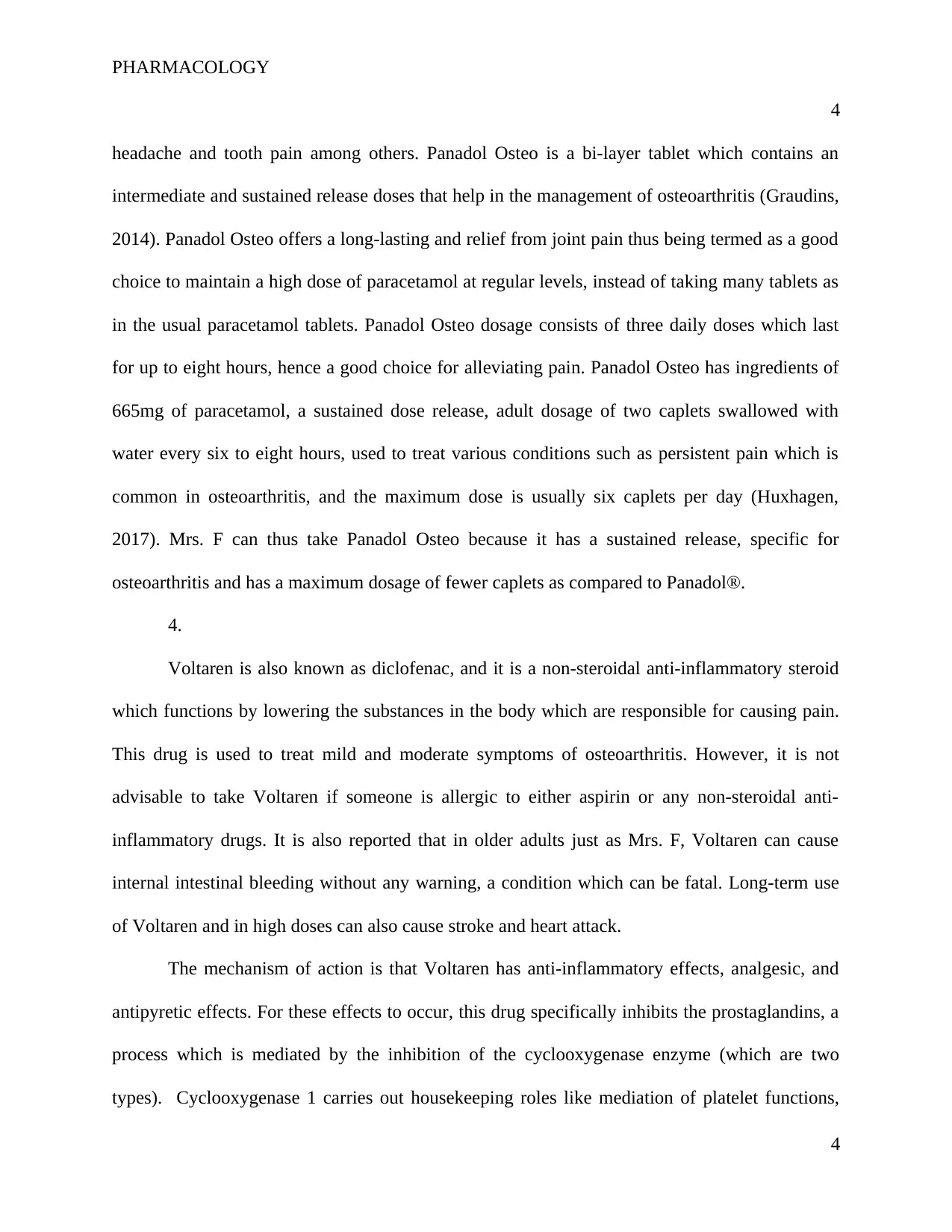
PHARMACOLOGY
4
headache and tooth pain among others. Panadol Osteo is a bi-layer tablet which contains an
intermediate and sustained release doses that help in the management of osteoarthritis (Graudins,
2014). Panadol Osteo offers a long-lasting and relief from joint pain thus being termed as a good
choice to maintain a high dose of paracetamol at regular levels, instead of taking many tablets as
in the usual paracetamol tablets. Panadol Osteo dosage consists of three daily doses which last
for up to eight hours, hence a good choice for alleviating pain. Panadol Osteo has ingredients of
665mg of paracetamol, a sustained dose release, adult dosage of two caplets swallowed with
water every six to eight hours, used to treat various conditions such as persistent pain which is
common in osteoarthritis, and the maximum dose is usually six caplets per day (Huxhagen,
2017). Mrs. F can thus take Panadol Osteo because it has a sustained release, specific for
osteoarthritis and has a maximum dosage of fewer caplets as compared to Panadol®.
4.
Voltaren is also known as diclofenac, and it is a non-steroidal anti-inflammatory steroid
which functions by lowering the substances in the body which are responsible for causing pain.
This drug is used to treat mild and moderate symptoms of osteoarthritis. However, it is not
advisable to take Voltaren if someone is allergic to either aspirin or any non-steroidal anti-
inflammatory drugs. It is also reported that in older adults just as Mrs. F, Voltaren can cause
internal intestinal bleeding without any warning, a condition which can be fatal. Long-term use
of Voltaren and in high doses can also cause stroke and heart attack.
The mechanism of action is that Voltaren has anti-inflammatory effects, analgesic, and
antipyretic effects. For these effects to occur, this drug specifically inhibits the prostaglandins, a
process which is mediated by the inhibition of the cyclooxygenase enzyme (which are two
types). Cyclooxygenase 1 carries out housekeeping roles like mediation of platelet functions,
4
4
headache and tooth pain among others. Panadol Osteo is a bi-layer tablet which contains an
intermediate and sustained release doses that help in the management of osteoarthritis (Graudins,
2014). Panadol Osteo offers a long-lasting and relief from joint pain thus being termed as a good
choice to maintain a high dose of paracetamol at regular levels, instead of taking many tablets as
in the usual paracetamol tablets. Panadol Osteo dosage consists of three daily doses which last
for up to eight hours, hence a good choice for alleviating pain. Panadol Osteo has ingredients of
665mg of paracetamol, a sustained dose release, adult dosage of two caplets swallowed with
water every six to eight hours, used to treat various conditions such as persistent pain which is
common in osteoarthritis, and the maximum dose is usually six caplets per day (Huxhagen,
2017). Mrs. F can thus take Panadol Osteo because it has a sustained release, specific for
osteoarthritis and has a maximum dosage of fewer caplets as compared to Panadol®.
4.
Voltaren is also known as diclofenac, and it is a non-steroidal anti-inflammatory steroid
which functions by lowering the substances in the body which are responsible for causing pain.
This drug is used to treat mild and moderate symptoms of osteoarthritis. However, it is not
advisable to take Voltaren if someone is allergic to either aspirin or any non-steroidal anti-
inflammatory drugs. It is also reported that in older adults just as Mrs. F, Voltaren can cause
internal intestinal bleeding without any warning, a condition which can be fatal. Long-term use
of Voltaren and in high doses can also cause stroke and heart attack.
The mechanism of action is that Voltaren has anti-inflammatory effects, analgesic, and
antipyretic effects. For these effects to occur, this drug specifically inhibits the prostaglandins, a
process which is mediated by the inhibition of the cyclooxygenase enzyme (which are two
types). Cyclooxygenase 1 carries out housekeeping roles like mediation of platelet functions,
4
Secure Best Marks with AI Grader
Need help grading? Try our AI Grader for instant feedback on your assignments.
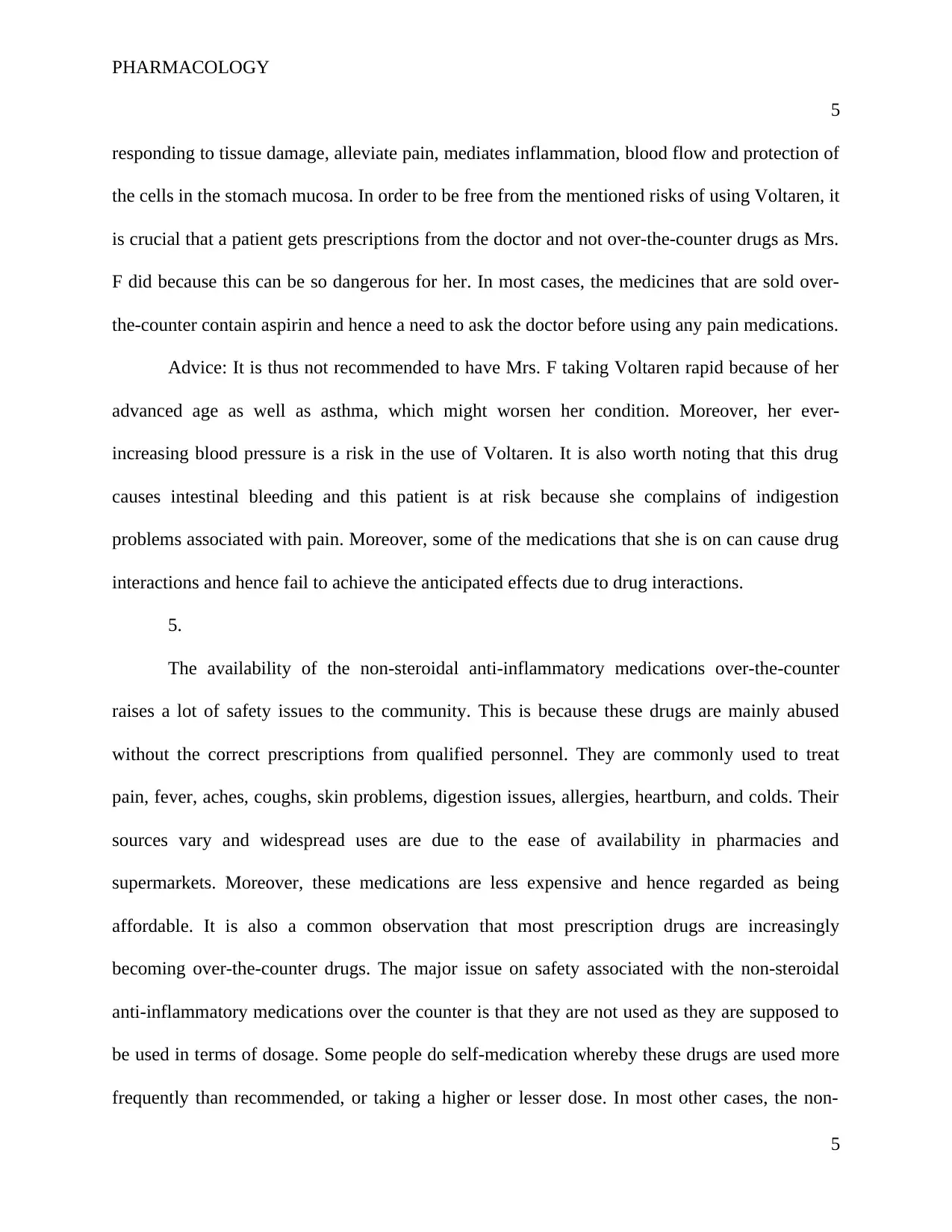
PHARMACOLOGY
5
responding to tissue damage, alleviate pain, mediates inflammation, blood flow and protection of
the cells in the stomach mucosa. In order to be free from the mentioned risks of using Voltaren, it
is crucial that a patient gets prescriptions from the doctor and not over-the-counter drugs as Mrs.
F did because this can be so dangerous for her. In most cases, the medicines that are sold over-
the-counter contain aspirin and hence a need to ask the doctor before using any pain medications.
Advice: It is thus not recommended to have Mrs. F taking Voltaren rapid because of her
advanced age as well as asthma, which might worsen her condition. Moreover, her ever-
increasing blood pressure is a risk in the use of Voltaren. It is also worth noting that this drug
causes intestinal bleeding and this patient is at risk because she complains of indigestion
problems associated with pain. Moreover, some of the medications that she is on can cause drug
interactions and hence fail to achieve the anticipated effects due to drug interactions.
5.
The availability of the non-steroidal anti-inflammatory medications over-the-counter
raises a lot of safety issues to the community. This is because these drugs are mainly abused
without the correct prescriptions from qualified personnel. They are commonly used to treat
pain, fever, aches, coughs, skin problems, digestion issues, allergies, heartburn, and colds. Their
sources vary and widespread uses are due to the ease of availability in pharmacies and
supermarkets. Moreover, these medications are less expensive and hence regarded as being
affordable. It is also a common observation that most prescription drugs are increasingly
becoming over-the-counter drugs. The major issue on safety associated with the non-steroidal
anti-inflammatory medications over the counter is that they are not used as they are supposed to
be used in terms of dosage. Some people do self-medication whereby these drugs are used more
frequently than recommended, or taking a higher or lesser dose. In most other cases, the non-
5
5
responding to tissue damage, alleviate pain, mediates inflammation, blood flow and protection of
the cells in the stomach mucosa. In order to be free from the mentioned risks of using Voltaren, it
is crucial that a patient gets prescriptions from the doctor and not over-the-counter drugs as Mrs.
F did because this can be so dangerous for her. In most cases, the medicines that are sold over-
the-counter contain aspirin and hence a need to ask the doctor before using any pain medications.
Advice: It is thus not recommended to have Mrs. F taking Voltaren rapid because of her
advanced age as well as asthma, which might worsen her condition. Moreover, her ever-
increasing blood pressure is a risk in the use of Voltaren. It is also worth noting that this drug
causes intestinal bleeding and this patient is at risk because she complains of indigestion
problems associated with pain. Moreover, some of the medications that she is on can cause drug
interactions and hence fail to achieve the anticipated effects due to drug interactions.
5.
The availability of the non-steroidal anti-inflammatory medications over-the-counter
raises a lot of safety issues to the community. This is because these drugs are mainly abused
without the correct prescriptions from qualified personnel. They are commonly used to treat
pain, fever, aches, coughs, skin problems, digestion issues, allergies, heartburn, and colds. Their
sources vary and widespread uses are due to the ease of availability in pharmacies and
supermarkets. Moreover, these medications are less expensive and hence regarded as being
affordable. It is also a common observation that most prescription drugs are increasingly
becoming over-the-counter drugs. The major issue on safety associated with the non-steroidal
anti-inflammatory medications over the counter is that they are not used as they are supposed to
be used in terms of dosage. Some people do self-medication whereby these drugs are used more
frequently than recommended, or taking a higher or lesser dose. In most other cases, the non-
5
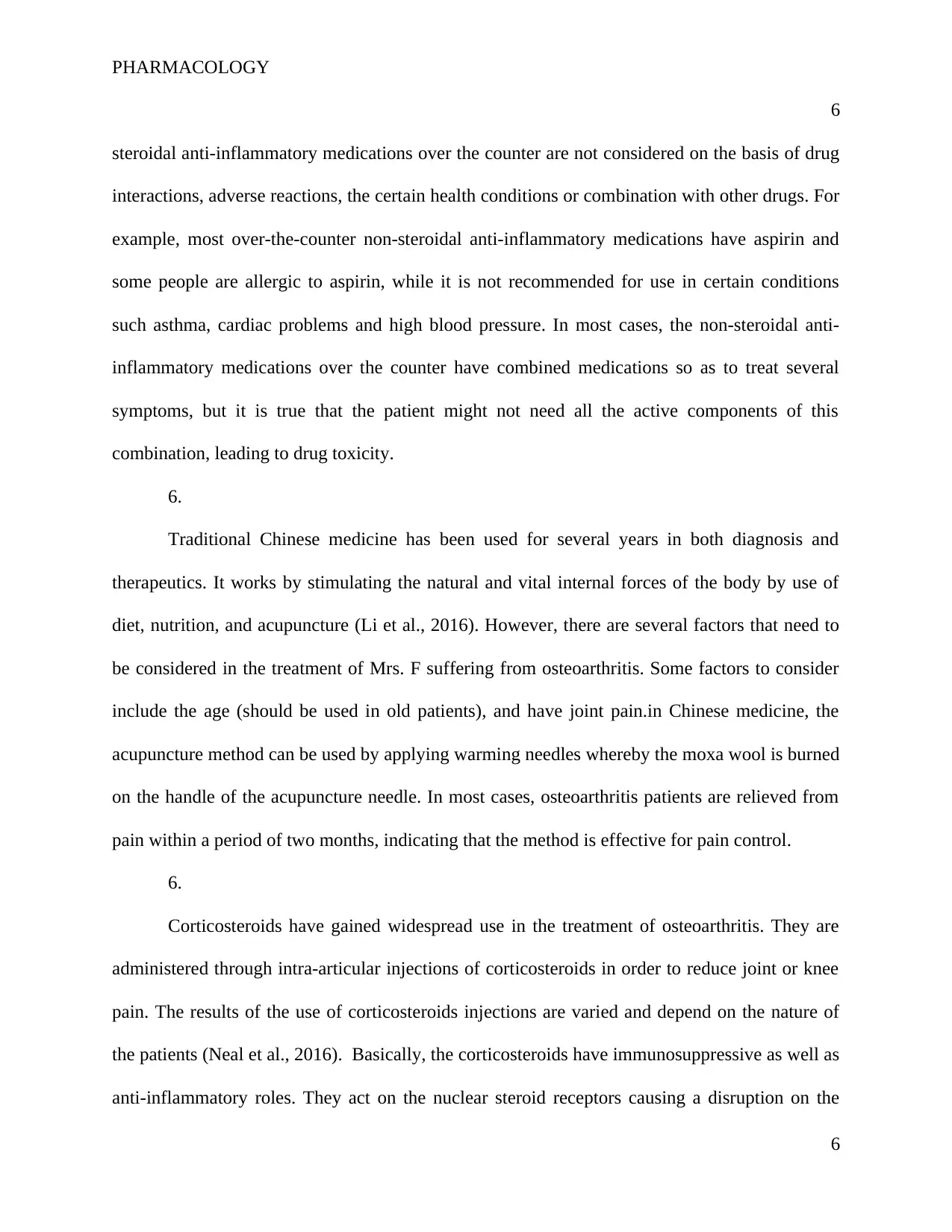
PHARMACOLOGY
6
steroidal anti-inflammatory medications over the counter are not considered on the basis of drug
interactions, adverse reactions, the certain health conditions or combination with other drugs. For
example, most over-the-counter non-steroidal anti-inflammatory medications have aspirin and
some people are allergic to aspirin, while it is not recommended for use in certain conditions
such asthma, cardiac problems and high blood pressure. In most cases, the non-steroidal anti-
inflammatory medications over the counter have combined medications so as to treat several
symptoms, but it is true that the patient might not need all the active components of this
combination, leading to drug toxicity.
6.
Traditional Chinese medicine has been used for several years in both diagnosis and
therapeutics. It works by stimulating the natural and vital internal forces of the body by use of
diet, nutrition, and acupuncture (Li et al., 2016). However, there are several factors that need to
be considered in the treatment of Mrs. F suffering from osteoarthritis. Some factors to consider
include the age (should be used in old patients), and have joint pain.in Chinese medicine, the
acupuncture method can be used by applying warming needles whereby the moxa wool is burned
on the handle of the acupuncture needle. In most cases, osteoarthritis patients are relieved from
pain within a period of two months, indicating that the method is effective for pain control.
6.
Corticosteroids have gained widespread use in the treatment of osteoarthritis. They are
administered through intra-articular injections of corticosteroids in order to reduce joint or knee
pain. The results of the use of corticosteroids injections are varied and depend on the nature of
the patients (Neal et al., 2016). Basically, the corticosteroids have immunosuppressive as well as
anti-inflammatory roles. They act on the nuclear steroid receptors causing a disruption on the
6
6
steroidal anti-inflammatory medications over the counter are not considered on the basis of drug
interactions, adverse reactions, the certain health conditions or combination with other drugs. For
example, most over-the-counter non-steroidal anti-inflammatory medications have aspirin and
some people are allergic to aspirin, while it is not recommended for use in certain conditions
such asthma, cardiac problems and high blood pressure. In most cases, the non-steroidal anti-
inflammatory medications over the counter have combined medications so as to treat several
symptoms, but it is true that the patient might not need all the active components of this
combination, leading to drug toxicity.
6.
Traditional Chinese medicine has been used for several years in both diagnosis and
therapeutics. It works by stimulating the natural and vital internal forces of the body by use of
diet, nutrition, and acupuncture (Li et al., 2016). However, there are several factors that need to
be considered in the treatment of Mrs. F suffering from osteoarthritis. Some factors to consider
include the age (should be used in old patients), and have joint pain.in Chinese medicine, the
acupuncture method can be used by applying warming needles whereby the moxa wool is burned
on the handle of the acupuncture needle. In most cases, osteoarthritis patients are relieved from
pain within a period of two months, indicating that the method is effective for pain control.
6.
Corticosteroids have gained widespread use in the treatment of osteoarthritis. They are
administered through intra-articular injections of corticosteroids in order to reduce joint or knee
pain. The results of the use of corticosteroids injections are varied and depend on the nature of
the patients (Neal et al., 2016). Basically, the corticosteroids have immunosuppressive as well as
anti-inflammatory roles. They act on the nuclear steroid receptors causing a disruption on the
6
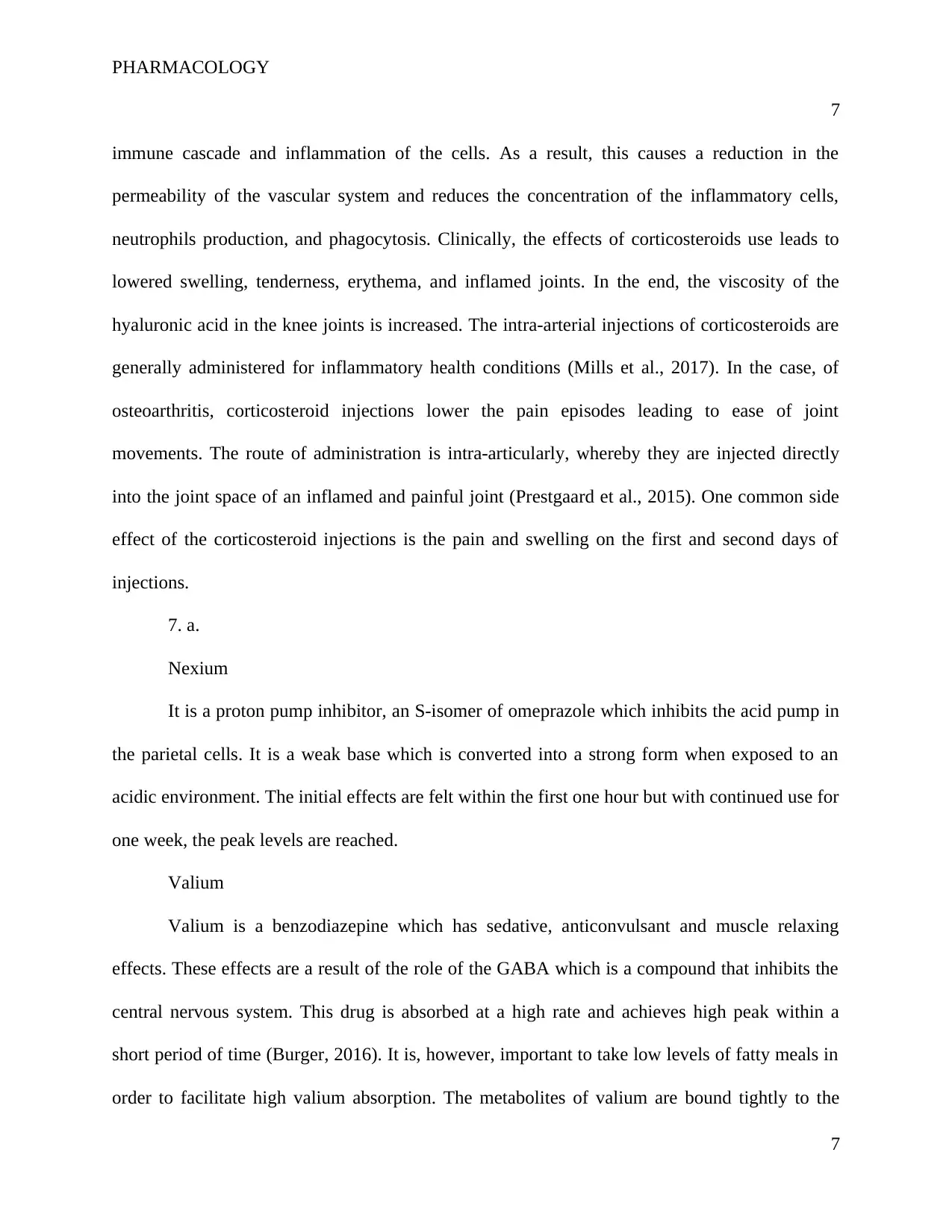
PHARMACOLOGY
7
immune cascade and inflammation of the cells. As a result, this causes a reduction in the
permeability of the vascular system and reduces the concentration of the inflammatory cells,
neutrophils production, and phagocytosis. Clinically, the effects of corticosteroids use leads to
lowered swelling, tenderness, erythema, and inflamed joints. In the end, the viscosity of the
hyaluronic acid in the knee joints is increased. The intra-arterial injections of corticosteroids are
generally administered for inflammatory health conditions (Mills et al., 2017). In the case, of
osteoarthritis, corticosteroid injections lower the pain episodes leading to ease of joint
movements. The route of administration is intra-articularly, whereby they are injected directly
into the joint space of an inflamed and painful joint (Prestgaard et al., 2015). One common side
effect of the corticosteroid injections is the pain and swelling on the first and second days of
injections.
7. a.
Nexium
It is a proton pump inhibitor, an S-isomer of omeprazole which inhibits the acid pump in
the parietal cells. It is a weak base which is converted into a strong form when exposed to an
acidic environment. The initial effects are felt within the first one hour but with continued use for
one week, the peak levels are reached.
Valium
Valium is a benzodiazepine which has sedative, anticonvulsant and muscle relaxing
effects. These effects are a result of the role of the GABA which is a compound that inhibits the
central nervous system. This drug is absorbed at a high rate and achieves high peak within a
short period of time (Burger, 2016). It is, however, important to take low levels of fatty meals in
order to facilitate high valium absorption. The metabolites of valium are bound tightly to the
7
7
immune cascade and inflammation of the cells. As a result, this causes a reduction in the
permeability of the vascular system and reduces the concentration of the inflammatory cells,
neutrophils production, and phagocytosis. Clinically, the effects of corticosteroids use leads to
lowered swelling, tenderness, erythema, and inflamed joints. In the end, the viscosity of the
hyaluronic acid in the knee joints is increased. The intra-arterial injections of corticosteroids are
generally administered for inflammatory health conditions (Mills et al., 2017). In the case, of
osteoarthritis, corticosteroid injections lower the pain episodes leading to ease of joint
movements. The route of administration is intra-articularly, whereby they are injected directly
into the joint space of an inflamed and painful joint (Prestgaard et al., 2015). One common side
effect of the corticosteroid injections is the pain and swelling on the first and second days of
injections.
7. a.
Nexium
It is a proton pump inhibitor, an S-isomer of omeprazole which inhibits the acid pump in
the parietal cells. It is a weak base which is converted into a strong form when exposed to an
acidic environment. The initial effects are felt within the first one hour but with continued use for
one week, the peak levels are reached.
Valium
Valium is a benzodiazepine which has sedative, anticonvulsant and muscle relaxing
effects. These effects are a result of the role of the GABA which is a compound that inhibits the
central nervous system. This drug is absorbed at a high rate and achieves high peak within a
short period of time (Burger, 2016). It is, however, important to take low levels of fatty meals in
order to facilitate high valium absorption. The metabolites of valium are bound tightly to the
7
Paraphrase This Document
Need a fresh take? Get an instant paraphrase of this document with our AI Paraphraser
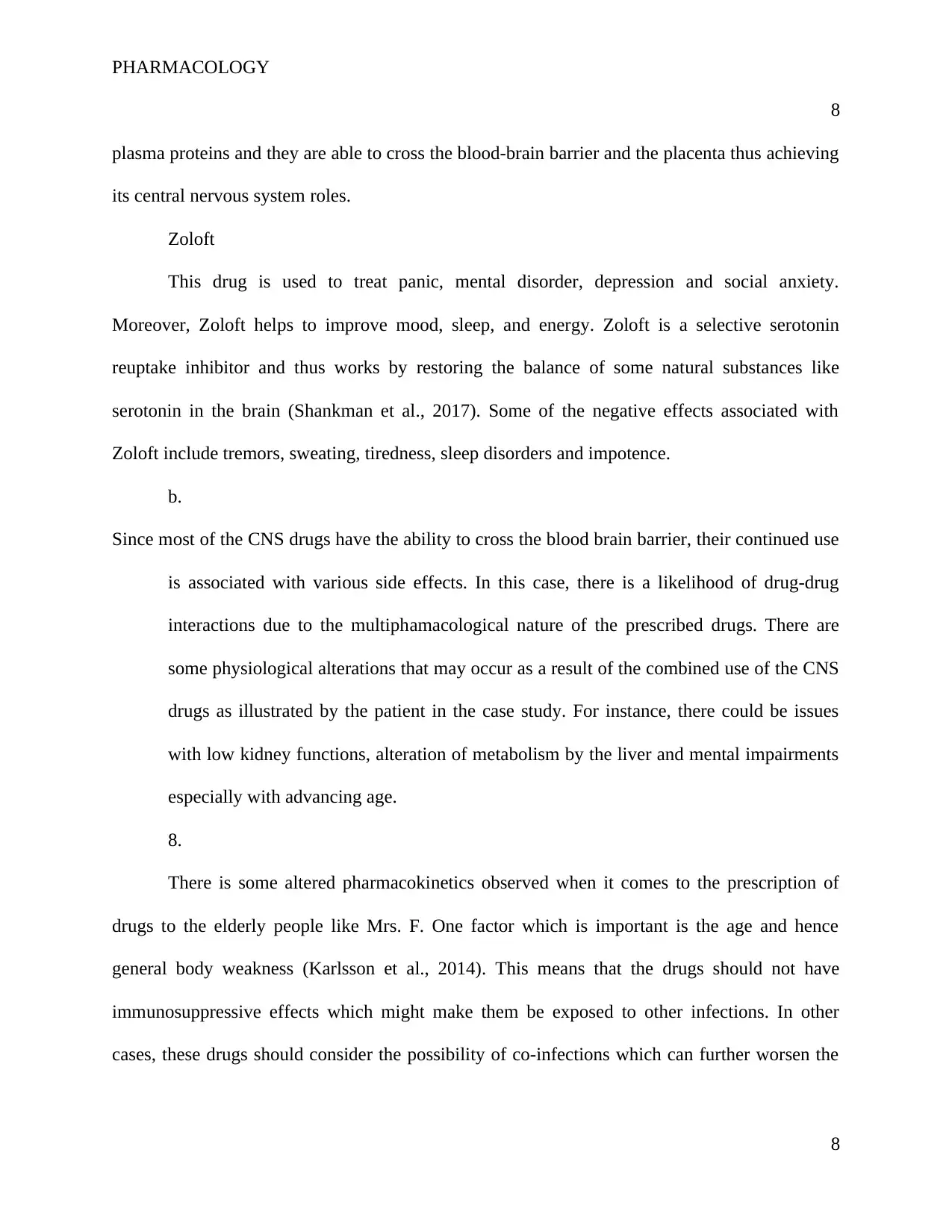
PHARMACOLOGY
8
plasma proteins and they are able to cross the blood-brain barrier and the placenta thus achieving
its central nervous system roles.
Zoloft
This drug is used to treat panic, mental disorder, depression and social anxiety.
Moreover, Zoloft helps to improve mood, sleep, and energy. Zoloft is a selective serotonin
reuptake inhibitor and thus works by restoring the balance of some natural substances like
serotonin in the brain (Shankman et al., 2017). Some of the negative effects associated with
Zoloft include tremors, sweating, tiredness, sleep disorders and impotence.
b.
Since most of the CNS drugs have the ability to cross the blood brain barrier, their continued use
is associated with various side effects. In this case, there is a likelihood of drug-drug
interactions due to the multiphamacological nature of the prescribed drugs. There are
some physiological alterations that may occur as a result of the combined use of the CNS
drugs as illustrated by the patient in the case study. For instance, there could be issues
with low kidney functions, alteration of metabolism by the liver and mental impairments
especially with advancing age.
8.
There is some altered pharmacokinetics observed when it comes to the prescription of
drugs to the elderly people like Mrs. F. One factor which is important is the age and hence
general body weakness (Karlsson et al., 2014). This means that the drugs should not have
immunosuppressive effects which might make them be exposed to other infections. In other
cases, these drugs should consider the possibility of co-infections which can further worsen the
8
8
plasma proteins and they are able to cross the blood-brain barrier and the placenta thus achieving
its central nervous system roles.
Zoloft
This drug is used to treat panic, mental disorder, depression and social anxiety.
Moreover, Zoloft helps to improve mood, sleep, and energy. Zoloft is a selective serotonin
reuptake inhibitor and thus works by restoring the balance of some natural substances like
serotonin in the brain (Shankman et al., 2017). Some of the negative effects associated with
Zoloft include tremors, sweating, tiredness, sleep disorders and impotence.
b.
Since most of the CNS drugs have the ability to cross the blood brain barrier, their continued use
is associated with various side effects. In this case, there is a likelihood of drug-drug
interactions due to the multiphamacological nature of the prescribed drugs. There are
some physiological alterations that may occur as a result of the combined use of the CNS
drugs as illustrated by the patient in the case study. For instance, there could be issues
with low kidney functions, alteration of metabolism by the liver and mental impairments
especially with advancing age.
8.
There is some altered pharmacokinetics observed when it comes to the prescription of
drugs to the elderly people like Mrs. F. One factor which is important is the age and hence
general body weakness (Karlsson et al., 2014). This means that the drugs should not have
immunosuppressive effects which might make them be exposed to other infections. In other
cases, these drugs should consider the possibility of co-infections which can further worsen the
8
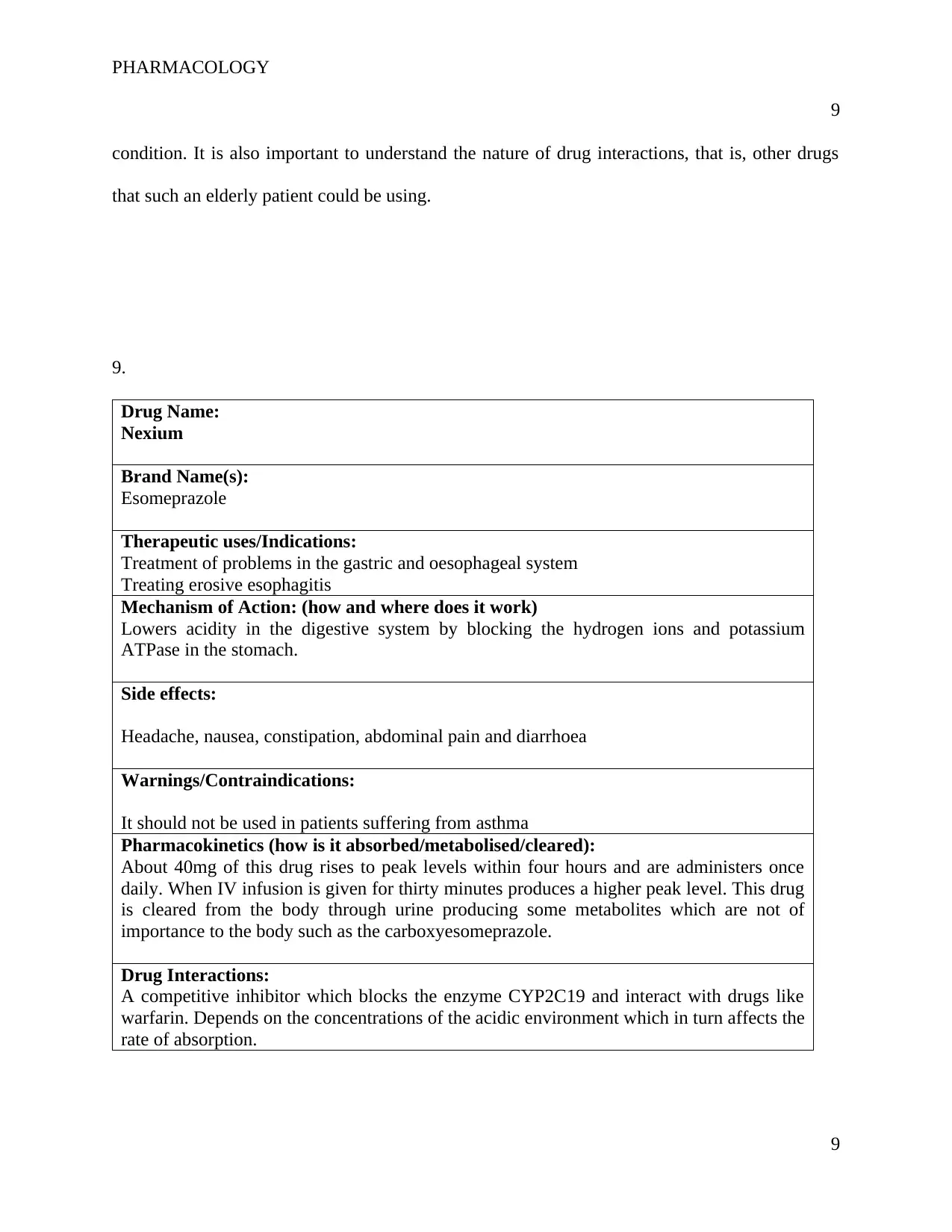
PHARMACOLOGY
9
condition. It is also important to understand the nature of drug interactions, that is, other drugs
that such an elderly patient could be using.
9.
Drug Name:
Nexium
Brand Name(s):
Esomeprazole
Therapeutic uses/Indications:
Treatment of problems in the gastric and oesophageal system
Treating erosive esophagitis
Mechanism of Action: (how and where does it work)
Lowers acidity in the digestive system by blocking the hydrogen ions and potassium
ATPase in the stomach.
Side effects:
Headache, nausea, constipation, abdominal pain and diarrhoea
Warnings/Contraindications:
It should not be used in patients suffering from asthma
Pharmacokinetics (how is it absorbed/metabolised/cleared):
About 40mg of this drug rises to peak levels within four hours and are administers once
daily. When IV infusion is given for thirty minutes produces a higher peak level. This drug
is cleared from the body through urine producing some metabolites which are not of
importance to the body such as the carboxyesomeprazole.
Drug Interactions:
A competitive inhibitor which blocks the enzyme CYP2C19 and interact with drugs like
warfarin. Depends on the concentrations of the acidic environment which in turn affects the
rate of absorption.
9
9
condition. It is also important to understand the nature of drug interactions, that is, other drugs
that such an elderly patient could be using.
9.
Drug Name:
Nexium
Brand Name(s):
Esomeprazole
Therapeutic uses/Indications:
Treatment of problems in the gastric and oesophageal system
Treating erosive esophagitis
Mechanism of Action: (how and where does it work)
Lowers acidity in the digestive system by blocking the hydrogen ions and potassium
ATPase in the stomach.
Side effects:
Headache, nausea, constipation, abdominal pain and diarrhoea
Warnings/Contraindications:
It should not be used in patients suffering from asthma
Pharmacokinetics (how is it absorbed/metabolised/cleared):
About 40mg of this drug rises to peak levels within four hours and are administers once
daily. When IV infusion is given for thirty minutes produces a higher peak level. This drug
is cleared from the body through urine producing some metabolites which are not of
importance to the body such as the carboxyesomeprazole.
Drug Interactions:
A competitive inhibitor which blocks the enzyme CYP2C19 and interact with drugs like
warfarin. Depends on the concentrations of the acidic environment which in turn affects the
rate of absorption.
9
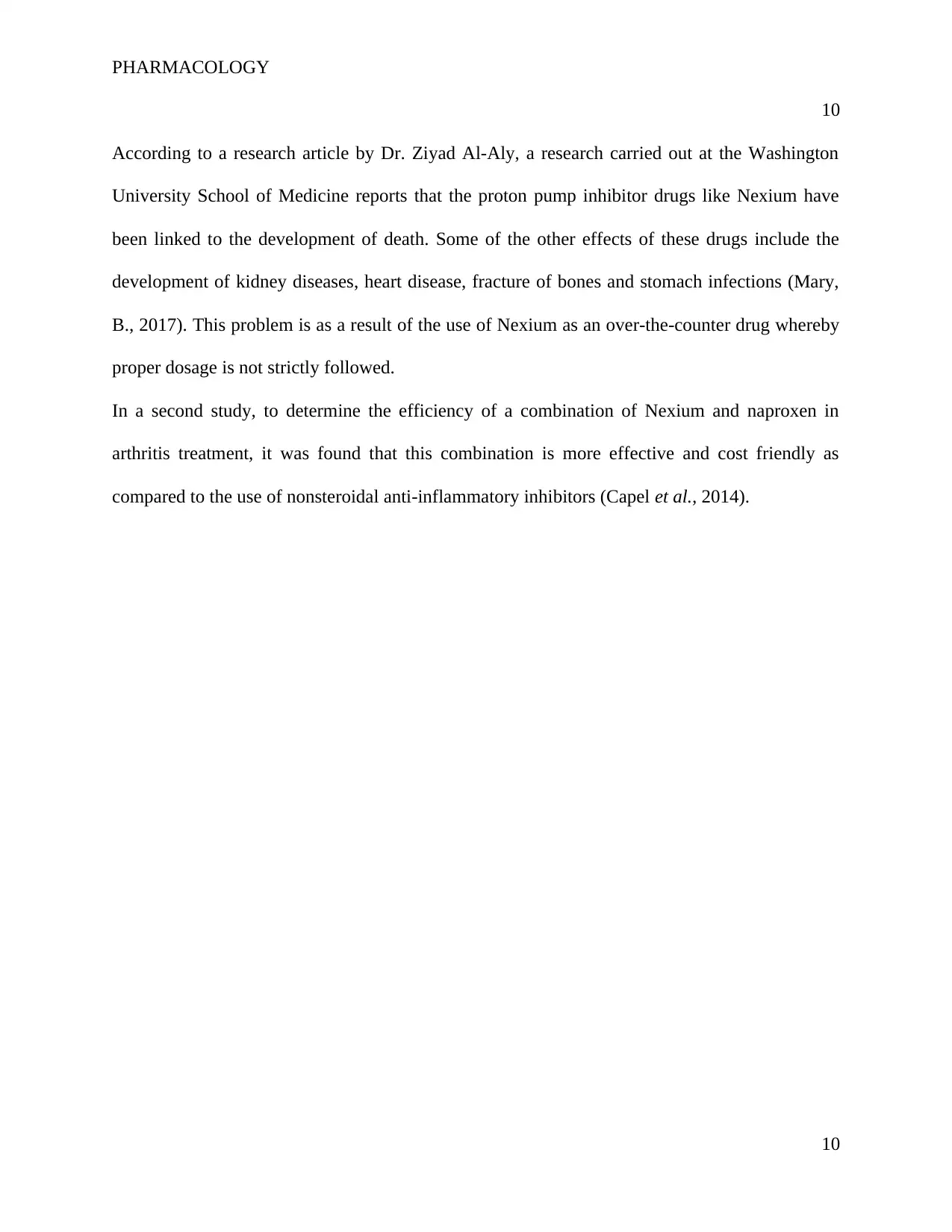
PHARMACOLOGY
10
According to a research article by Dr. Ziyad Al-Aly, a research carried out at the Washington
University School of Medicine reports that the proton pump inhibitor drugs like Nexium have
been linked to the development of death. Some of the other effects of these drugs include the
development of kidney diseases, heart disease, fracture of bones and stomach infections (Mary,
B., 2017). This problem is as a result of the use of Nexium as an over-the-counter drug whereby
proper dosage is not strictly followed.
In a second study, to determine the efficiency of a combination of Nexium and naproxen in
arthritis treatment, it was found that this combination is more effective and cost friendly as
compared to the use of nonsteroidal anti-inflammatory inhibitors (Capel et al., 2014).
10
10
According to a research article by Dr. Ziyad Al-Aly, a research carried out at the Washington
University School of Medicine reports that the proton pump inhibitor drugs like Nexium have
been linked to the development of death. Some of the other effects of these drugs include the
development of kidney diseases, heart disease, fracture of bones and stomach infections (Mary,
B., 2017). This problem is as a result of the use of Nexium as an over-the-counter drug whereby
proper dosage is not strictly followed.
In a second study, to determine the efficiency of a combination of Nexium and naproxen in
arthritis treatment, it was found that this combination is more effective and cost friendly as
compared to the use of nonsteroidal anti-inflammatory inhibitors (Capel et al., 2014).
10
Secure Best Marks with AI Grader
Need help grading? Try our AI Grader for instant feedback on your assignments.
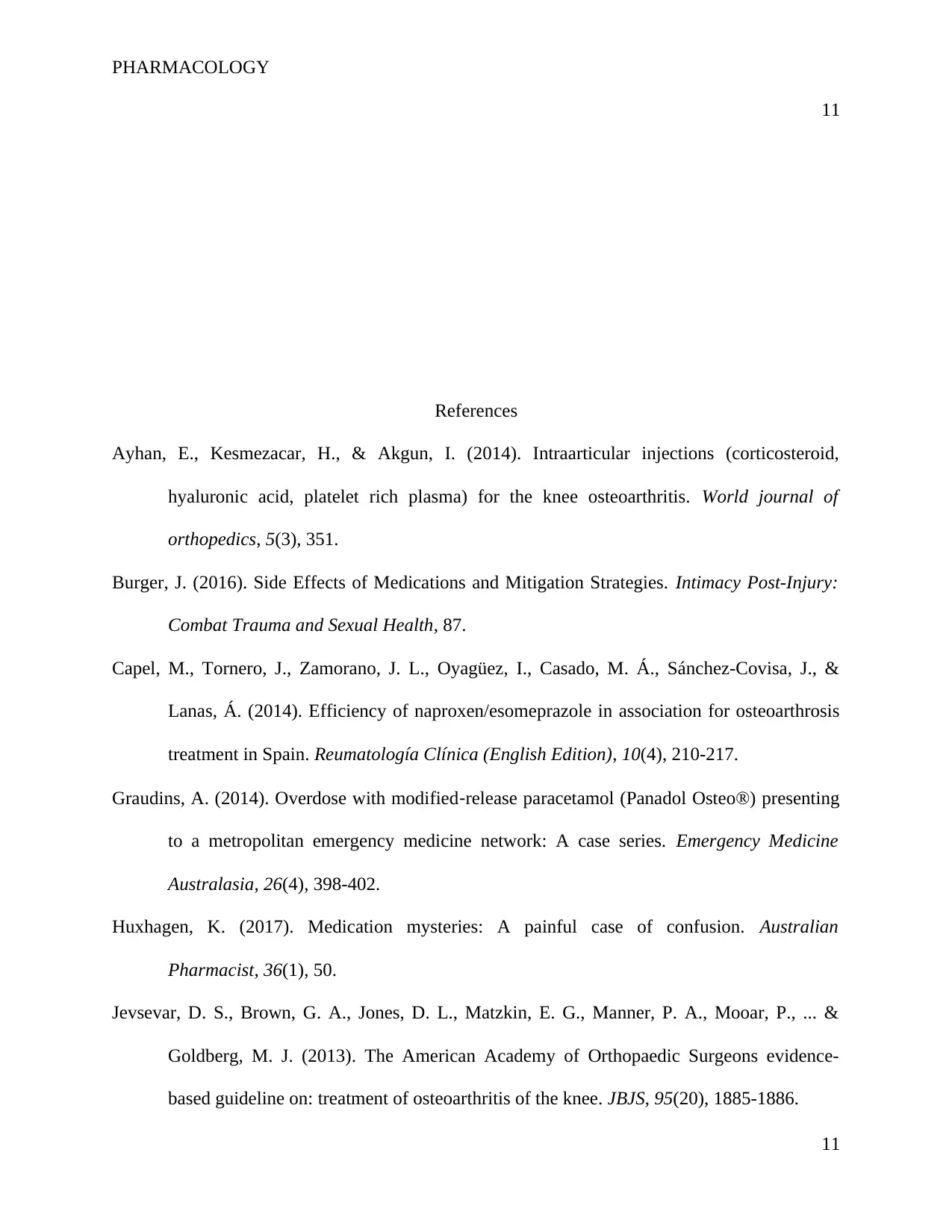
PHARMACOLOGY
11
References
Ayhan, E., Kesmezacar, H., & Akgun, I. (2014). Intraarticular injections (corticosteroid,
hyaluronic acid, platelet rich plasma) for the knee osteoarthritis. World journal of
orthopedics, 5(3), 351.
Burger, J. (2016). Side Effects of Medications and Mitigation Strategies. Intimacy Post-Injury:
Combat Trauma and Sexual Health, 87.
Capel, M., Tornero, J., Zamorano, J. L., Oyagüez, I., Casado, M. Á., Sánchez-Covisa, J., &
Lanas, Á. (2014). Efficiency of naproxen/esomeprazole in association for osteoarthrosis
treatment in Spain. Reumatología Clínica (English Edition), 10(4), 210-217.
Graudins, A. (2014). Overdose with modified‐release paracetamol (Panadol Osteo®) presenting
to a metropolitan emergency medicine network: A case series. Emergency Medicine
Australasia, 26(4), 398-402.
Huxhagen, K. (2017). Medication mysteries: A painful case of confusion. Australian
Pharmacist, 36(1), 50.
Jevsevar, D. S., Brown, G. A., Jones, D. L., Matzkin, E. G., Manner, P. A., Mooar, P., ... &
Goldberg, M. J. (2013). The American Academy of Orthopaedic Surgeons evidence-
based guideline on: treatment of osteoarthritis of the knee. JBJS, 95(20), 1885-1886.
11
11
References
Ayhan, E., Kesmezacar, H., & Akgun, I. (2014). Intraarticular injections (corticosteroid,
hyaluronic acid, platelet rich plasma) for the knee osteoarthritis. World journal of
orthopedics, 5(3), 351.
Burger, J. (2016). Side Effects of Medications and Mitigation Strategies. Intimacy Post-Injury:
Combat Trauma and Sexual Health, 87.
Capel, M., Tornero, J., Zamorano, J. L., Oyagüez, I., Casado, M. Á., Sánchez-Covisa, J., &
Lanas, Á. (2014). Efficiency of naproxen/esomeprazole in association for osteoarthrosis
treatment in Spain. Reumatología Clínica (English Edition), 10(4), 210-217.
Graudins, A. (2014). Overdose with modified‐release paracetamol (Panadol Osteo®) presenting
to a metropolitan emergency medicine network: A case series. Emergency Medicine
Australasia, 26(4), 398-402.
Huxhagen, K. (2017). Medication mysteries: A painful case of confusion. Australian
Pharmacist, 36(1), 50.
Jevsevar, D. S., Brown, G. A., Jones, D. L., Matzkin, E. G., Manner, P. A., Mooar, P., ... &
Goldberg, M. J. (2013). The American Academy of Orthopaedic Surgeons evidence-
based guideline on: treatment of osteoarthritis of the knee. JBJS, 95(20), 1885-1886.
11
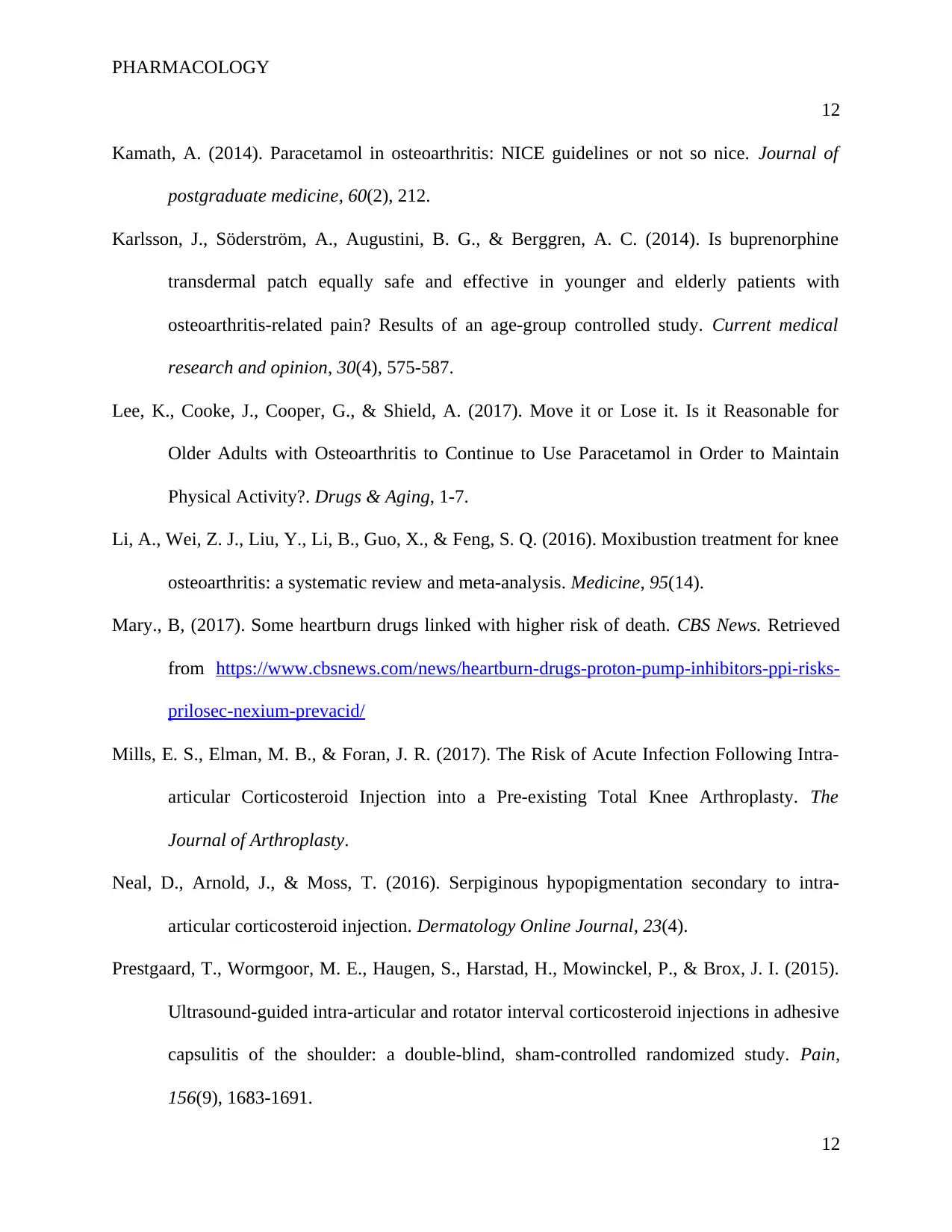
PHARMACOLOGY
12
Kamath, A. (2014). Paracetamol in osteoarthritis: NICE guidelines or not so nice. Journal of
postgraduate medicine, 60(2), 212.
Karlsson, J., Söderström, A., Augustini, B. G., & Berggren, A. C. (2014). Is buprenorphine
transdermal patch equally safe and effective in younger and elderly patients with
osteoarthritis-related pain? Results of an age-group controlled study. Current medical
research and opinion, 30(4), 575-587.
Lee, K., Cooke, J., Cooper, G., & Shield, A. (2017). Move it or Lose it. Is it Reasonable for
Older Adults with Osteoarthritis to Continue to Use Paracetamol in Order to Maintain
Physical Activity?. Drugs & Aging, 1-7.
Li, A., Wei, Z. J., Liu, Y., Li, B., Guo, X., & Feng, S. Q. (2016). Moxibustion treatment for knee
osteoarthritis: a systematic review and meta-analysis. Medicine, 95(14).
Mary., B, (2017). Some heartburn drugs linked with higher risk of death. CBS News. Retrieved
from https://www.cbsnews.com/news/heartburn-drugs-proton-pump-inhibitors-ppi-risks-
prilosec-nexium-prevacid/
Mills, E. S., Elman, M. B., & Foran, J. R. (2017). The Risk of Acute Infection Following Intra-
articular Corticosteroid Injection into a Pre-existing Total Knee Arthroplasty. The
Journal of Arthroplasty.
Neal, D., Arnold, J., & Moss, T. (2016). Serpiginous hypopigmentation secondary to intra-
articular corticosteroid injection. Dermatology Online Journal, 23(4).
Prestgaard, T., Wormgoor, M. E., Haugen, S., Harstad, H., Mowinckel, P., & Brox, J. I. (2015).
Ultrasound-guided intra-articular and rotator interval corticosteroid injections in adhesive
capsulitis of the shoulder: a double-blind, sham-controlled randomized study. Pain,
156(9), 1683-1691.
12
12
Kamath, A. (2014). Paracetamol in osteoarthritis: NICE guidelines or not so nice. Journal of
postgraduate medicine, 60(2), 212.
Karlsson, J., Söderström, A., Augustini, B. G., & Berggren, A. C. (2014). Is buprenorphine
transdermal patch equally safe and effective in younger and elderly patients with
osteoarthritis-related pain? Results of an age-group controlled study. Current medical
research and opinion, 30(4), 575-587.
Lee, K., Cooke, J., Cooper, G., & Shield, A. (2017). Move it or Lose it. Is it Reasonable for
Older Adults with Osteoarthritis to Continue to Use Paracetamol in Order to Maintain
Physical Activity?. Drugs & Aging, 1-7.
Li, A., Wei, Z. J., Liu, Y., Li, B., Guo, X., & Feng, S. Q. (2016). Moxibustion treatment for knee
osteoarthritis: a systematic review and meta-analysis. Medicine, 95(14).
Mary., B, (2017). Some heartburn drugs linked with higher risk of death. CBS News. Retrieved
from https://www.cbsnews.com/news/heartburn-drugs-proton-pump-inhibitors-ppi-risks-
prilosec-nexium-prevacid/
Mills, E. S., Elman, M. B., & Foran, J. R. (2017). The Risk of Acute Infection Following Intra-
articular Corticosteroid Injection into a Pre-existing Total Knee Arthroplasty. The
Journal of Arthroplasty.
Neal, D., Arnold, J., & Moss, T. (2016). Serpiginous hypopigmentation secondary to intra-
articular corticosteroid injection. Dermatology Online Journal, 23(4).
Prestgaard, T., Wormgoor, M. E., Haugen, S., Harstad, H., Mowinckel, P., & Brox, J. I. (2015).
Ultrasound-guided intra-articular and rotator interval corticosteroid injections in adhesive
capsulitis of the shoulder: a double-blind, sham-controlled randomized study. Pain,
156(9), 1683-1691.
12
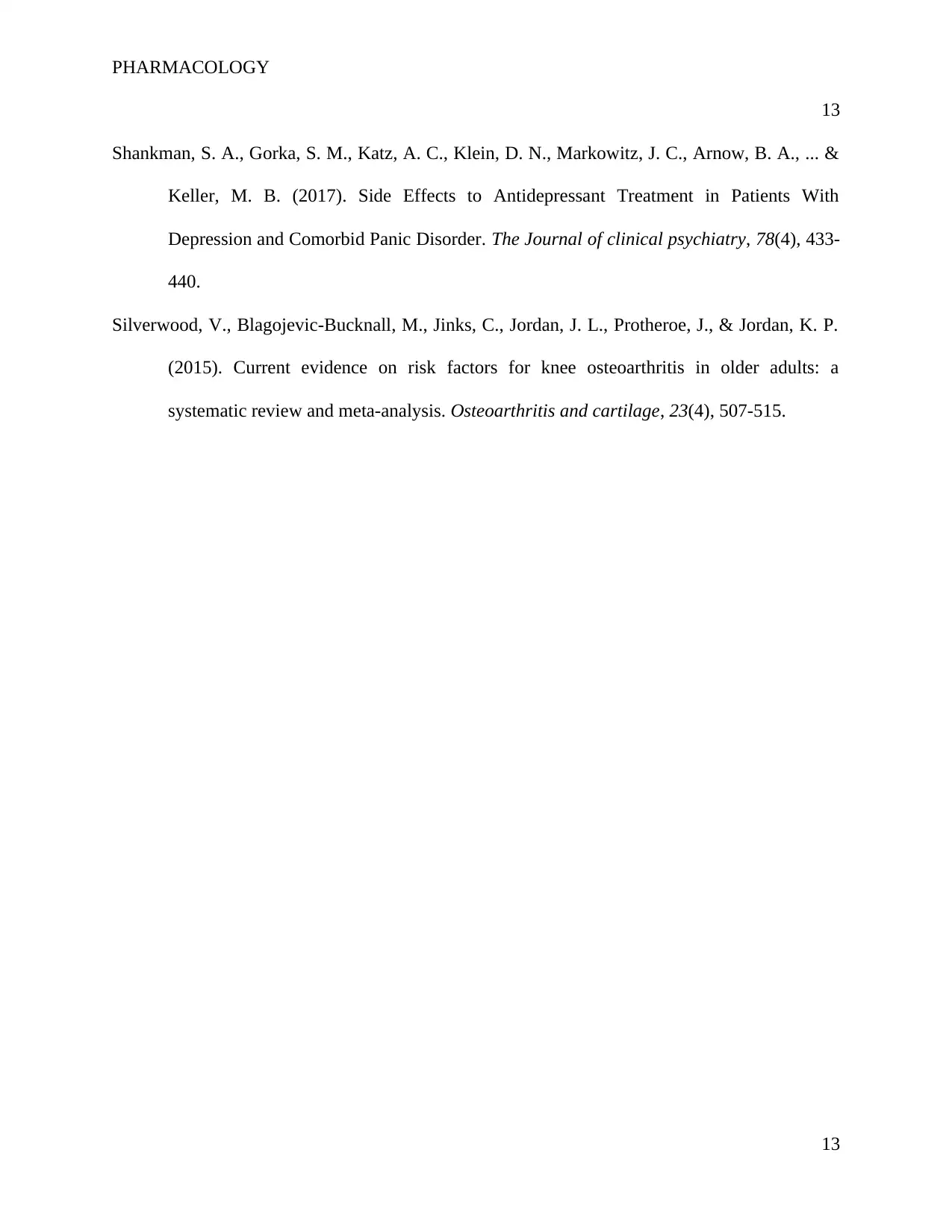
PHARMACOLOGY
13
Shankman, S. A., Gorka, S. M., Katz, A. C., Klein, D. N., Markowitz, J. C., Arnow, B. A., ... &
Keller, M. B. (2017). Side Effects to Antidepressant Treatment in Patients With
Depression and Comorbid Panic Disorder. The Journal of clinical psychiatry, 78(4), 433-
440.
Silverwood, V., Blagojevic-Bucknall, M., Jinks, C., Jordan, J. L., Protheroe, J., & Jordan, K. P.
(2015). Current evidence on risk factors for knee osteoarthritis in older adults: a
systematic review and meta-analysis. Osteoarthritis and cartilage, 23(4), 507-515.
13
13
Shankman, S. A., Gorka, S. M., Katz, A. C., Klein, D. N., Markowitz, J. C., Arnow, B. A., ... &
Keller, M. B. (2017). Side Effects to Antidepressant Treatment in Patients With
Depression and Comorbid Panic Disorder. The Journal of clinical psychiatry, 78(4), 433-
440.
Silverwood, V., Blagojevic-Bucknall, M., Jinks, C., Jordan, J. L., Protheroe, J., & Jordan, K. P.
(2015). Current evidence on risk factors for knee osteoarthritis in older adults: a
systematic review and meta-analysis. Osteoarthritis and cartilage, 23(4), 507-515.
13
1 out of 13
Related Documents
Your All-in-One AI-Powered Toolkit for Academic Success.
+13062052269
info@desklib.com
Available 24*7 on WhatsApp / Email
![[object Object]](/_next/static/media/star-bottom.7253800d.svg)
Unlock your academic potential
© 2024 | Zucol Services PVT LTD | All rights reserved.





